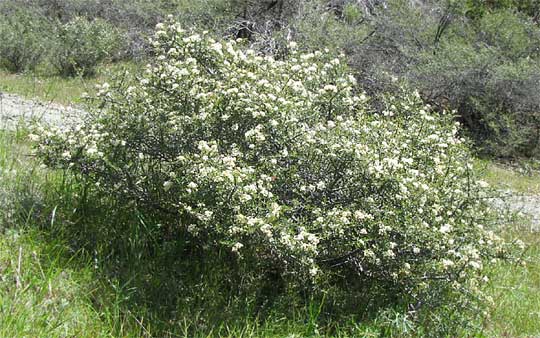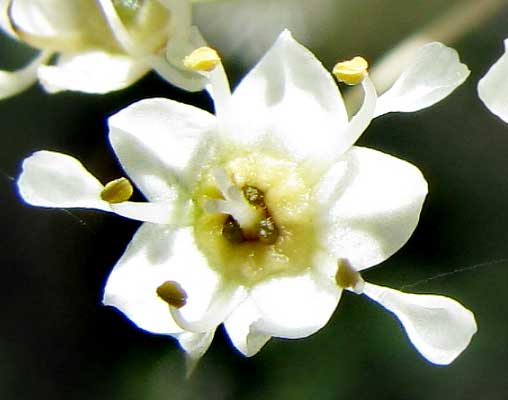Excerpts from Jim Conrad's
Naturalist Newsletter
from the May 17, 2009 Newsletter, issued from the Siskiyou Mountains west of Grants Pass, Oregon:
BUCKBRUSH
Several shrubs go by the name of Buckbrush. The one I've been watching began flowering over a month ago, then each week more flowers appeared, and this week it's been spectacular. You can see a waist-high one below:

That's CEANOTHUS CUNEATUS, very common here along roads and on dry, open slopes. A closer view shows its small, evergreen, opposite leaves and stiff twigs arising at right angles to the main branches and ending in semi-sharp, spinelike tips below:

Below, you can see that its tiny blossoms are elegant enough to take a closer look at:

The large, white, star-shaped feature is its five sepals, or calyx lobes, modified to do the attention-getting service done by the petals or corollas of most other flowers. You can make out the five matchstick-like stamens tipped with yellowish, pollen-holding anthers. Below each stamen arises a slender, reduced petal. Notice how the style arising from the disk-surrounded ovary below is 3- branched. It's a little unusual for petals to arise opposite stamens instead of alternating with them. Buckbrushes are members of the Buckthorn Family, the Rhamnaceae.
This Buckbrush species is distributed from Oregon south through California to northern Baja, Mexico. The leaves and flowers make an excellent tea when steeped in boiling water for about five minutes. A green dye can be obtained from the flowers, while the root produces a red dye. Its stems have been used as rods in basket making. All parts of the plant, rich in saponins, can be crushed and mixed with water to produce a soapy lather effective for washing dirt, though it doesn't cut oil and grease. If you pound fresh flowers in water you end up with a perfumed lather. Indigenous Americans formerly wove the branches together to form fish dams across streams.